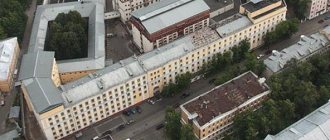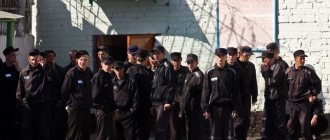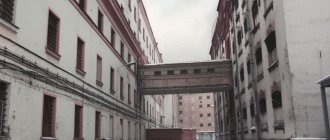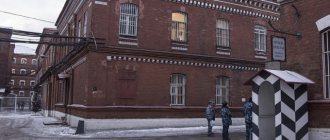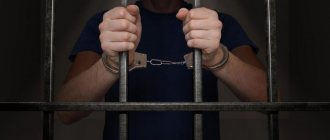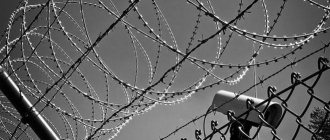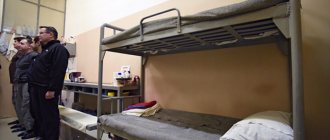Story
Contrary to popular belief, the Sailor's Silence prison is not called that because it was intended exclusively for sailors. In fact, even under Peter the Great, a settlement for elderly sailors who had retired was located in this area. Subsequently, in 1771, an almshouse was founded there. A special decree prohibited all types of transport from traveling along this street. Thanks to the predominant contingent and the silence reigning there, it received such a name.
The first prison-type institution appeared on Matrosskaya Tishina Street in 1775 under Catherine II. According to the decree of the empress, the most daring and notorious criminals were placed there. Later, in 1850, the Church of the Icon “Joy of All Who Sorrow” was founded at the prison.
In 1870, the prison began to bear the name of the Moscow Correctional Prison. The building was designed to accommodate 150 women and 300 men. Gradually the territory grew, the number of residents also grew, and the need arose for a new building, which was erected in 1912 according to the design of the architect B.A. Alberti.
During the revolutionary years, the prison initially fell into disrepair, but already in 1918 they decided to reorganize it. On the basis of an already existing institution, a correctional institution was founded, where “criminal elements” (mostly young, aged 17 to 21) were reforged and re-educated, learning to work honestly for the good of the Soviet homeland. But, not having lived even a year, the so-called “Reformatorium” went into oblivion. On its basis, the Kozhevnicheskaya children's correctional colony was created.
Sailor's silence under the USSR
In 1945, the correctional facility for children became quite an “adult” facility. In 1947, new buildings were completed, and Matrosskaya Tishina could accommodate more than 2,000 prisoners. At the same time, barracks for the prison employees themselves, a boiler room, and an administrative building were erected on the territory.
In 1949, another building appeared - specifically for the detention of Nazi criminals, as well as scientists who suffered from the second round of Stalinist repressions. Scientists worked here in the so-called “sharashkas”. Subsequently (in 1953), the third building was converted to house juvenile delinquents - here they were engaged in socially useful work (making Christmas tree decorations, envelopes, etc.). For their work, they were given money with which they could purchase goods in the prison shop. The children's prison closed only in 1997. Since 1999, the third building began to be used as a department of the in-prison hospital.
In 1985, the prison was converted into a pre-trial detention center.
Reconstruction
As of 1947, there were two sensitive facilities on the territory of the institution, the first and second buildings, respectively. The Matrosskaya Tishina prison could simultaneously accommodate more than 2,000 prisoners. In addition, there were also outbuildings on the territory of the establishment:
- a boiler room that continues to function today;
- barrack-type residential buildings built from wood, intended for employees;
- administration building;
- barracks for service personnel.
For prisoners’ walks, special areas were equipped on the territory of the utility yard. The walking yard looked like a circle, surrounded by a wooden fence around the perimeter. Security on the towers and outside was carried out by servicemen of the Moscow internal troops from the Bogorodsk division.
A little later, in 1949, a third building was built to house prisoners. It had the status of a special prison and had its own entrance (from the side of psychiatric hospital No. 3), as well as its own commanders and separate security. Mostly, those awaiting trial, Nazi criminals and convicts working in the Special Technical Bureau of the Ministry of Internal Affairs (inventors, designers, engineers) served their sentences there. Popularly, such prisons were called “sharashkin’s offices.” Life in one of these “sharashkas” was talentedly described in detail by Alexander Isaakievich Solzhenitsyn in his book “In the First Circle”.
From the beginning of 1950, over the course of two years, the administrative buildings of the prison were refurbished. The first and second security facilities were supplemented with 4th and 5th floors and exercise yards. Until now, convicts take walks in these courtyards located on the roofs of buildings.
In the early 50s of the last century, administrative decisions designed to divide such institutions into city and regional ones entailed the need to expand Prison No. 14. In this regard, it was renamed Prison No. 1, better known among the people as the Matrosskaya prison Silence".
After the death of L.P. Beria, since 1953, juvenile criminals were serving their sentences in building No. 3. The penitentiary service was engaged in the education of teenagers (convicts had the opportunity to receive secondary education), employment - minor prisoners, working in workshops at the prison, made envelopes, Christmas tree decorations and other consumer goods. The money earned could be spent on your needs by purchasing available goods at the stall. The children's prison existed until 1997. Afterwards, it was decided to reconstruct and repair the third building. And since 1999, it has become the tuberculosis department at the prison hospital.
The hospital itself for prisoners was located in the renovated and reconstructed buildings of the former housing stock of prison employees. The institution serves not only Matrosskaya Tishina, but also all pre-trial detention centers in the city of Moscow. The hospital has approximately 706 hospital beds.
Over the past decades, various construction and repair work has been constantly carried out on the territory of “Matrosskaya Tishina”:
- in 1997, a catering unit (equipped with modern equipment) was put into operation;
- in 1987 – central heating station;
- in the early 90s, the third building was renovated;
- in the mid-2000s, a major overhaul of the first building of the prison was carried out
- in accordance with sanitary standards, cells for convicted persons and persons under investigation are equipped;
- the courtyards for walking are covered with a roof;
- Today, a major overhaul of the second building of the prison is underway.
According to the management of the penitentiary service, the necessary work is constantly being carried out in order to maintain the buildings of the institution in proper condition. Today the Matrosskaya Tishina prison has 7 buildings.
Famous prison escapes
Mostly bandits, thieves in law, etc. sat in Matrosskaya Tishina. (for example, everyone knows Volodya Sharapov’s phrase from the film “The meeting place cannot be changed”: “And then they will take him to Matrosskaya Tishina prison - and the khan, you won’t escape from there.”
In reality, escaping from the legendary “Sailor” is quite possible. Probably the most famous - and at the same time successful - escape from here was made by the killer Alexander Solonik. A former special forces soldier who killed such famous authorities as Valery Dlukach, Vladislav Vanner and Nikolai Prichinich. Solonik was called “killer No. 1.”
Alexander Solonik
Alexander managed to bribe the guard, and he brought him special climbing equipment and a pistol. A mannequin was left in the cell to create the appearance of the prisoner's presence. And the fugitives themselves (the warden Sergei Menshikov fled with Solonik) climbed onto the roof through the ventilation system and went down using a rope. However, their fate was sad: Menshikov was killed in the same year, 1995, Solonik - in 1997.
At the same time, we’ll tell you about other successful escapes. True, these prisoners were less fortunate - they were captured within a few days.
In 2004, Sergei Ershov, a citizen of Ukraine, escaped from Matrosskaya Tishina. He managed to dismantle the brickwork and overcome the high fence. Of course, the fugitive received serious injuries and was detained again a day later.
In 2013, Oleg Topalov, who was in jail on charges of theft and double murder, managed to escape from Matroska using the same method as Solonik escaped in the 1990s. Topalov bribed the guard, who brought him a climbing kit, the prisoner climbed onto the roof and easily went down to the street. However, a search for the fugitive was announced immediately, and exactly 24 hours later Oleg Topalov was detained. Interestingly, he was later acquitted of theft and murder, but had to serve a sentence for his escape.
Oleg Topalov
“Matrosskaya Tishina” - all about prison
“Matrosskaya Silence” is the unofficial name of Moscow pre-trial detention center No. 1. PKU SIZO-1 UFSIN of Russia for the city of Moscow - the full official name, the abbreviations of which are deciphered as follows - “Federal government institution Pre-trial detention center No. 1 of the Office of the Federal Penitentiary Service for the city of Moscow.” Next, we will consider in detail the features of this institution, the conditions of detention in it, as well as the history of this place.
Address and contacts
Pre-trial detention center No. 1 is located in Moscow, at the address: st. Matrosskaya Tishina, 18, postal code – 107076.
The telephone number of the duty department is (499)2684356, and if necessary, you can also send a fax to it. On the official website of the institution, another duty department number is provided - (499) 2683693, and there is also a helpline number - (499) 2687338. E-mail of the institution The official website of the pre-trial detention center is located at: https://sizo-1.ru/. You can get to the official page of the institution in the GUFSIN by clicking on the link - https://www.77.fsin.su/structure/sizo_1/, but keep in mind that information on the operating hours and reception of transfers in pre-trial detention center No. 1 was last updated there in 2015.
Reception of citizens by management
Since 2022, the head of pre-trial detention center No. 1 in Moscow is Anton Stanislavovich Podrez, a colonel of the internal service. They receive citizens on Thursdays, from 9:30 to 16:30 and every Friday, from 9:30 to 15:30. At certain hours, it is possible to meet with his deputies: Tuesday, from 9:30 to 16:30 - deputy head for general issues; Monday, Wednesday, from 9:30 to 16:30 - Deputy Head of Security and Regime
Opening hours and visiting schedule Based on the information provided on the official website of “Matroskaya Tishina”, parcels (grocery) are accepted from Mon. on Thurs. from 9:30 to 16:30 and on Fri. from 9.30 to 15:30. Please note that every fourth Monday of the month there is a sanitary day and parcels are not accepted!
Lawyers and police officers can contact the investigative department of pre-trial detention center No. 1 with any questions that arise from Mon. on Thurs. from 09:15 to 17:45 and on Fri. from 09:15 to 16:30. Lunch break – from 13:00 to 13:45. If there is an appropriate doctor’s prescription, those staying in “Matrosskaya Tishina” are allowed to transfer medications. Reception is carried out from Mon. on Thurs. from 9:30 to 16:30, and on Fri. from 9:30 to 15:30. In “Matrosskaya Tishina” short visits lasting no more than 3 hours are allowed. An application for such a date can be submitted from Mon. on Thurs. to 15:00, and on Fri. until 14:00. The previously agreed upon dates themselves take place on Mon. on Fri. until 17:30. Visits are not held on the last Friday of each month - sanitary day. The schedule for receiving transmissions and meetings with people under investigation may change on holidays. You need to check the information on the official website or directly with the pre-trial detention center staff.
Infrastructure
The institution consists of seven secure buildings, two of which are reserved for a hospital, one of them is used to house people diagnosed with tuberculosis, and another, the fifth building, is a dormitory for the economic detachment. In total, in “Matrosskaya Tishina” there are 316 cells with a total area of 5866.4 sq.m. There are 15 punishment cells in the pre-trial detention center, where you can get into them for various violations. The total area of the detention center is 41,438 square meters, and in addition to the security buildings, on its territory there is a bakery, a catering unit, a garage, a boiler room, a printing house, a bath and laundry plant and a canteen for personnel.
Why do they come here?
A pre-trial detention center should not be confused with a prison or a colony, since, for the most part, people there do not serve time, but are kept in custody during the investigation and trial. In some cases, a prisoner may remain in a pre-trial detention center even after the verdict is announced. This happens in cases where an appeal has been filed or the prisoner is awaiting transfer to the penitentiary institution where he will serve his sentence according to the court decision. Any prisoner can be sent to pre-trial detention center No. 1, regardless of the classification and severity of the crime with which he is accused. But among the people, “Matrosskaya Tishina” is better known as “a pre-trial detention center for the elite,” since it is there that officials, ministers, famous businessmen and oligarchs await trial during the investigation.
Conditions of detention
The area of a typical cell in pre-trial detention center No. 1 is 12 sq.m. and each is designed for 3-4 people. Almost every cell has a TV, a refrigerator, and there is always a toilet and washbasin. The beds are bunk. There is no set uniform for prisoners.
Daily routine of prisoners
The regime of detention in a pre-trial detention center is practically no different from the regimes established in prisons and colonies. In “Matrosskaya Tishina”, as in all pre-trial detention centers, wake-up occurs at 6:00. A loud beep alerts all occupants that it is time to wake up. Breakfast starts at 6:30, followed by lunch and dinner. Between 8 and 9 a.m. there is a mandatory daily inspection of the cells. At this time, prisoners can submit their complaints and suggestions, if any, to the convoy. During the day there are daily walks, the average duration of which is 1 hour. Once a week, every prisoner has the right to visit the bathhouse or shower. The duration of water procedures is no more than 15 minutes. The light in the cell is on around the clock, but after lights out, 10 p.m., it switches to night mode and becomes dimmer.
The history of "Matrosskaya Silence"
The “Matrosskaya Tishina” detention center owes its name to the street on which it is located. In the second half of the 18th century, by the decision of Peter I, a sailors' settlement was created on the banks of the Yauza River. In this place it became customary to settle old sailors who, for health reasons or due to age, could not continue to participate in naval battles. Such people needed peace and quiet, and according to the corresponding order, the movement of any type of transport was prohibited on this street. The area where the sailors lived became very quiet, which is why it received the name “Sailor’s Silence.” The street on which the pre-trial detention center is located today has retained its name to this day, thanks to which, among the people, the same name has unofficially been assigned to the pre-trial detention center. The history of the emergence of the pre-trial detention center itself is quite interesting and begins back in 1775. Then, on the site where the pre-trial detention center now stands, a certain correctional institution was formed, where petty thieves and swindlers were sent for re-education. While serving their sentences, they tried to teach them some kind of craft at the same time. In 1870, this place received the name of the Moscow Correctional Prison. Further, the Bolsheviks who came to power in 1918 converted the prison into a correctional facility for minors and called it “Reformatory for persons under 21 years of age.” Over the years, the institution changed its name, expanded its territory, but always remained a place with a correctional bias. The history of “Matrosskaya Tishina” as a pre-trial detention center, known today, began only in 1946. It was from this time that the archives contain a record of prison No. 14, which was founded on Matrosskaya Tishina Street. In the post-war period, in 1949-1950, in the cells of this prison, Nazis and war criminals awaited the verdict of the tribunal. Later, the facility acquired the status of a special prison during the period of Stalin’s repressions; inventors, engineers and other representatives of intellectual work were kept there. At the end of the 1970s, the so-called “Cotton Case” caused great resonance throughout the Union, during which a number of senior officials of the Uzbek SSR were accused of serious corruption and economic crimes. The investigation went on for many years, and it was then that the question arose that there was no place in Moscow where, during the investigation, prisoners who required special control could be kept. As a result, the Minister of Internal Affairs of the USSR issued an order, on the basis of which, on September 1, 1985, a Special Pretrial Detention Center of the Ministry of Internal Affairs of the USSR was created on the basis of “Matrosskaya Tishina”. Over the course of history, the subordination of this place changed several times, as did its name, but, in fact, it remained a pre-trial detention center for holding prisoners during the investigation, awaiting trial or transfer to the place of serving their sentences.
The most famous prisoners
Many famous people have visited the walls of “Matrosskaya Tishina” in their time. The artist Yumatov and the politician Lukyanov were kept in custody there. Along with recognized representatives of criminals, such as, for example, Vyacheslav Ivankov (better known under the nickname Yaponchik), ex-representatives of the highest ranks of government awaited their future fate within the walls of “Matrosskaya Tishina”, for example, Marshal of the Soviet Union Dmitry Yazov, a member of the Central Committee CPSU Valery Boldin, USSR Vice President Gennady Yanaev. The walls of pre-trial detention center No. 1 saw both businessmen and fraudsters. At one time, the builder of the odious financial pyramid Sergei Mavrodi, also Mikhail Khodorkovsky, known for a high-profile case related to the oil industry, stayed there. Many remember how in August 2006 Moscow was shaken by an explosion at the Cherkizovsky market. One of its organizers, terrorist Oleg Kostarev, was awaiting his life sentence in pre-trial detention center No. 1. A lot of noise was made by Dionisy Zolotov, accused of fraud and embezzlement, who was kept in “Matrosskaya Tishina” in special conditions of increased comfort and from whom, in fact, the scandal related to the presence of VIP cells in the pre-trial detention center began. Also, the killer Alexander Solonik visited the walls of pre-trial detention center No. 1, becoming one of the few who managed to escape from the detention center.
Solonik's escape from Sailor's Silence
Solonik made his successful escape on June 5, 1995. It was not possible to find him, but after almost two years, on 02/02/1997, he was found murdered in Greece. As a particularly dangerous criminal, the killer was kept in solitary confinement. While making a routine night round at 1:20, the pre-trial detention center employees noticed that guard Sergei Menshikov was not at his workplace. When examining Solonik’s cell, it became clear that the prisoner was also missing. During the investigation, it turned out that, having entered into a conspiracy, the killer and the pre-trial detention center worker went out together to the exercise area of the 9th building, somehow climbed the wall, climbed over it and went down to the street. If Solonik was found dead in Greece in 1997, then nothing is still known about Menshikov, who helped him escape. In 2003, an escape attempt less successful than Solonik’s was attempted by a prisoner named Delgura. In the detention center, he became part of the housekeeping team and had the opportunity to move freely around the territory of Matrosskaya Tishina. On March 13, he was not found during the morning check, but four days later Delgyura was found in the sanitary inspection room of the pre-trial detention center, where he tried to hide from the guards. In September of the same year, 2003, another escape was organized in “Matrosskaya Tishina”, which can be considered successful. Prisoner Slavgorodsky Vasily managed to knock out several bricks from the fence surrounding the exercise yard. Having crawled through the resulting hole, he jumped over the wall-fence and found himself free. But Slavgorodsky did not stay there for long; in May of the following year he was nevertheless detained. In a similar way, in May 2004, another inmate, Alexander Ershov, tried to escape from Matrosskaya Tishina. He also managed to make a hole in the wall while walking. Next, the fugitive climbed onto the roof of the warehouses and managed to jump over the main wall. They caught him relatively quickly - 2 days later, not far from Moscow, in Lyubertsy. The management still had to reveal all the details of the escape of another prisoner in “Matrosskaya Tishina”, since the incident caused a special resonance among the public. In 2013, a native of Sochi, Oleg Topalov, was awaiting trial in pre-trial detention center No. 1.
The man was suspected of involvement in the murder of Yuri Zvezdochkin, the owner of the Rostov. Also, Topalov was accused of membership in a killer group, the leader of which was a man with the pseudonym Ded Khasan. Topalov decided to flee. To do this, he managed to dig into the soft ceiling with an ordinary tablespoon, climbed into the ventilation shaft and managed to reach the roof of the neighboring building. Thus, Topalov was freed. About 100 experienced criminal investigation officers were sent to search for him, dog handlers worked actively, but the dogs lost his trail near the embankment of the Yauza River. The paradoxical thing was that after such a well-planned escape, the fugitive himself simply had nowhere to go. The next day, May 8, two canine sergeants discovered him completely by accident. Topalov was simply sitting on a bench. The incident provoked many inspections of Matrosskaya Tishina. The investigative committee brought charges under Art. 293 of the Criminal Code of the Russian Federation. As a result of internal inspections, many FSIN employees were punished, two of them were fired. But the most interesting thing was that during the trial Topalov was completely acquitted. Neither his involvement in the murder nor his presence in the killer group was proven and he was released straight from the courtroom. All charges against him were dropped, except one - under Art. 315. Criminal Code of the Russian Federation - “Escape”.
Modernity
The cells in Matrosskaya Tishina are designed to hold 3-4 prisoners. Each cell has a refrigerator and a TV. However, according to the latest data, there is obvious overcrowding in the prison, and sometimes inmates even have to take turns sleeping.
There are regular reports in the media about periodic violations of the rights of prisoners in this prison. The latest such high-profile case is the murder of the defendant Alexei Shangin in 2015. A 35-year-old man was brutally tortured; the torture lasted more than a day. The Muscovite died from painful shock; his body was found to have a traumatic brain injury, combined injuries, burns to the head, legs and arms. Due to unacceptable treatment of a prisoner, the head of the operational department, Mikhail Zakharov, was fired. According to investigators, the murder was committed by Alexei's cellmates. But perhaps they were simply following orders from someone from the prison authorities? One way or another, there is no complete clarity in this matter yet. And information about the use of unacceptable measures of influence in “Matroska” is leaked to the media with enviable regularity.
Alexey Shangin
Pre-trial detention center No. 1 of the Federal Penitentiary Service of Russia
Officially, the date of creation of pre-trial detention center No. 1 is September 1, 1985. Based on the order of the USSR Ministry of Internal Affairs, pre-trial detention center No. 1 was created on the basis of the seventh security building of the prison. This institution has long been nicknamed “Sailor’s Silence” among the people. Address: Moscow, Matrosskaya Tishina street, building 18. Located in the Eastern Administrative District of the capital. The total area of the institution is 41,438 square meters. m.
Initially, the limit of prisoners that the pre-trial detention center could contain did not exceed 200 people. The pre-trial detention center was intended to isolate for the period of investigative actions and trial persons in respect of whom it was necessary to take strict supervisory measures.
In 2001, based on international standards regarding the size of space per prisoner, a limit was set on the capacity of the prison.
But, unfortunately, the standards are not actually met. According to official data, pre-trial detention center No. 1 is designed for 2,013 people, but the actual capacity exceeds this figure by 21.3% and amounts to 2,441 people.
Today, having gone through a chain of renamings over all the years of its existence, the institution of the penitentiary service has been renamed the Federal State Institution “Pretrial Detention Facility No. 1 of the Federal Penitentiary Service of Russia” (the abbreviated name is FKU Pre-trial Detention Center-1 of the Federal Penitentiary Service of Russia).
In addition to pre-trial detention center 1, Moscow has seven more pre-trial detention centers. Among them are the equally famous Butyrka and Lefortovo.
Daily routine in prison
Prisoners wake up at 6:00 a.m. and go to bed at 10:00 p.m. Sleeping or lying on beds during the daytime is strictly prohibited. Prisoners are notified of the need to wake up or go to bed by an audio signal. The light in the cells never goes out; at night it is simply switched to a less powerful mode.
The menu for breakfast, lunch and dinner is practically no different; each meal consists of standard three courses.
You are allowed to wash once a week - in a bathhouse or shower, and you need to do it for 15 minutes.
Walks are held daily and take an average of one hour. The cameras are visited every day from 8 to 9 am.
Daily routine in prison
In popular culture
The “Matrosskaya Tishina” pre-trial detention center has been repeatedly mentioned in various works of art, ranging from criminal lyrics and literature, authored by former prisoners as well, to performances and documentaries.
View this post on Instagram
A post shared by Victor Ray (@v1cr4v)
Photo of the interior of the pre-trial detention center “Matrosskaya Silence”
So, several books have been written with the title “Matrosskaya Silence” and dedicated to the pre-trial detention center. The authors distinguished themselves: Ivan Mazutin, Boris Sedov, Valery Karyshev. Alexander Galich, who created the play of the same name, although the work does not directly address the institution, makes it a kind of symbol of unfreedom in Soviet post-war Russia.
Alexander Marshal and Evgeny Kemerovsky, Igor Slutsky and Mikhail Grubov, as well as dozens of other singers working in the genre of thieves' lyrics, sang songs about “Sailor's Silence”. And as a setting, the pre-trial detention center has repeatedly appeared in all kinds of fiction and documentaries.
The case of VIP cameras
In 2022, a scandal broke out and several people were removed from leadership positions. The thing is that so-called “VIP cells” were discovered in the prison, equipped with greater amenities than the others. They were completely renovated, had a plasma TV, a refrigerator, high-quality furniture, showers, a separate toilet, etc. Only fairly wealthy inmates could enjoy such conditions - mostly thieves or dangerous swindlers.
VIP chamber interior
In VIP cells it was allowed to use mobile phones; if desired, a person could sit in such a cell alone or with other people (who were also asked for their consent). As a justification, the prison authorities cited the argument that the proceeds from such cells go to improve the living conditions of other prisoners.
When news of the VIP conditions leaked to the media, representatives of the Federal Penitentiary Service wrote in every possible way that in fact there were no special cells - some were simply lucky with the repairs, and others were not. However, former prisoners claim that for a bribe you can use, for example, a mobile phone even in a regular cell. Also, some concessions are granted to patients - they may sometimes be allowed to order food separately, including from catering establishments (restaurants, cafes).
Shepherd's word
At the end of the 19th century, a temple was erected on the territory of the prison, in which church representatives conducted services. Unfortunately, during the turbulent revolutionary years, the Bolsheviks destroyed the structure.
The period of “godlessness” on the territory of the pre-trial detention center lasted almost a century. Only in 2022, in “Matrosskaya Tishina”, a prison temple of the icon of the Mother of God “Joy of All Who Sorrow” was erected. Services are now held here weekly on weekends. And a regularly visiting priest teaches detainees in pre-trial detention centers awaiting trial and sentencing how to pray correctly. And he conducts soul-saving conversations with those who want to improve.

